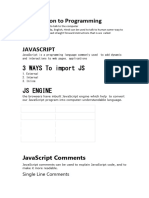1 JavaScript
Uploaded by
Liado Jiu1 JavaScript
Uploaded by
Liado JiuJavaScript
Technologies That Drive the Web
By: Engr. Richard P. Cabales
Comment in JavaScript
// This is an in-line comment.
/* This is a
multi-line comment */
By: Engr. Richard P. Cabales
Declare JavaScript Variables
var myName;
By: Engr. Richard P. Cabales
Storing Values with the Assignment
Operator
var a;
var b = 2;
a = 7;
By: Engr. Richard P. Cabales
Assigning the Value of One Variable
to Another
var a;
a = 100;
var b;
b=7;
b=a;
By: Engr. Richard P. Cabales
Initializing Variables with the
Assignment Operator
var a = 9
By: Engr. Richard P. Cabales
Understanding String Literals
var myFirstName = "Richard"
var myLastName = ’Cabales’
By: Engr. Richard P. Cabales
Understanding Uninitialized
Variables
var a; var a = 5;
var b; var b = 10;
var c; var c = "I am a";
a = a + 1; a = a + 1;
b = b + 5; b = b + 5;
c = c + " String!"; c = c + " String!";
By: Engr. Richard P. Cabales
Understanding Case Sensitivity in
Variables
// Declarations
var studlyCapVar;
var properCamelCase;
var titleCaseOver;
// Assignments in camel case
studlyCapVar = 10;
properCamelCase = "A String";
titleCaseOver = 9000;
By: Engr. Richard P. Cabales
Differences Between the var and let
Keywords
var camper = "James"; let camper = "James";
var camper = "David"; let camper = "David";
console.log(camper); console.log(camper);
By: Engr. Richard P. Cabales
Declare a Read-Only Variable with
the const Keyword
const PI = 3.14159;
let str = "is cool!";
str = "is the value of PI!";
console.log(PI, str);
By: Engr. Richard P. Cabales
Add Two Numbers with JavaScript
const sum = 10 + 10;
By: Engr. Richard P. Cabales
Add Two Numbers with JavaScript
const sum = 10 + 10;
By: Engr. Richard P. Cabales
Subtract One Number from Another
with JavaScript
const difference = 45 - 33;
By: Engr. Richard P. Cabales
Multiply Two Numbers with
JavaScript
const product = 8 * 10;
By: Engr. Richard P. Cabales
Divide One Number by Another with
JavaScript
const quotient = 66 / 33;
By: Engr. Richard P. Cabales
Increment a Number with JavaScript
let myVar = 87;
myVar++;
By: Engr. Richard P. Cabales
Decrement a Number with
JavaScript
let myVar = 11;
myVar--;
By: Engr. Richard P. Cabales
Multiply Two Decimals with
JavaScript
const product = 2.0 * 2.5;
By: Engr. Richard P. Cabales
Multiply Two Decimals with
JavaScript
const product = 2.0 * 2.5;
By: Engr. Richard P. Cabales
Divide One Decimal by Another with
JavaScript
const quotient = 4.4 / 2.0;
By: Engr. Richard P. Cabales
Divide One Decimal by Another with
JavaScript
const quotient = 4.4 / 2.0;
By: Engr. Richard P. Cabales
Finding a Remainder in JavaScript
const remainder = 11%3;
By: Engr. Richard P. Cabales
Compound Assignment With
Augmented Addition
let a = 3;
let b = 17;
let c = 12;
a += 12; // a = a+12
b += 9; // b = b+9
c += 7; // c = c+7
By: Engr. Richard P. Cabales
Compound Assignment With
Augmented Subtraction
let a = 11;
let b = 9;
let c = 3;
a -= 6; //a = a - 6;
b -= 15; //b = b - 15;
c -= 1; //c = c - 1;
By: Engr. Richard P. Cabales
Compound Assignment With
Augmented Multiplication
let a = 5;
let b = 12;
let c = 4.6;
a *= 5; //a = a * 5;
b *= 3; //b = b * 3;
c *= 10 //c = c * 10;
By: Engr. Richard P. Cabales
Compound Assignment With
Augmented Division
let a = 5;
let b = 12;
let c = 4.6;
a /= 5; //a = a * 5;
b /= 3; //b = b * 3;
c /= 10 //c = c * 10;
By: Engr. Richard P. Cabales
Escaping Literal Quotes in Strings
const myStr = "I am a \"double quoted\" string inside \"double quotes\".";
By: Engr. Richard P. Cabales
Quoting Strings with Single Quotes
const doubleQuoteStr = "This is a string";
const singleQuoteStr = 'This is also a string';
const conversation = 'Finn exclaims to Jake, "Algebraic!"';
const goodStr = 'Jake asks Finn, "Hey, let\'s go on an adventure?"';
const badStr = 'Finn responds, "Let's go!"';
const myStr = '<a href="http://www.example.com" target="_blank">Link</a>';
By: Engr. Richard P. Cabales
Escape Sequences in Strings
const myStr="FirstLine\n\t\\SecondLine\nThirdLine";
By: Engr. Richard P. Cabales
Concatenating Strings with Plus
Operator
const myStr = "This is the start. " + "This is the end.";
By: Engr. Richard P. Cabales
Constructing Strings with Variables
const myName = "Richard Cabales";
const myStr = "Hello, my name is " + myName + ", how are you?";
By: Engr. Richard P. Cabales
Appending Variables to Strings
const someAdjective = "Exciting";
let myStr = "Learning to code is ";
myStr += someAdjective
By: Engr. Richard P. Cabales
Find the Length of a String
console.log(“Richard Cabales".length);
let lastNameLength = 0;
const lastName = "dela Cruz";
lastNameLength = lastName.length;
By: Engr. Richard P. Cabales
Use Bracket Notation to Find the
First Character in a String
const firstName = "Charles";
const firstLetter = firstName[0];
let firstLetterOfLastName = "";
const lastName = "Lovelace";
firstLetterOfLastName = lastName[0];
By: Engr. Richard P. Cabales
Understand String Immutability
let myStr = "Bob";
myStr[0] = "J";
let myStr = "Bob";
myStr = "Job";
let myStr = "Jello World";
myStr = "Hello World";
By: Engr. Richard P. Cabales
Use Bracket Notation to Find the
Nth Character in a String
const lastName = "Lovelace";
const thirdLetterOfLastName = lastName[2];
By: Engr. Richard P. Cabales
Use Bracket Notation to Find the
Last Character in a String
const firstName = "Ada";
const lastLetter = firstName[firstName.length - 1];
By: Engr. Richard P. Cabales
Use Bracket Notation to Find the
Last Character in a String
const firstName = "Ada";
const lastLetter = firstName[firstName.length - 1];
By: Engr. Richard P. Cabales
Use Bracket Notation to Find the
Nth-to-Last Character in a String
const firstName = "Augusta";
const thirdToLastLetter = firstName[firstName.length - 3];
By: Engr. Richard P. Cabales
Word Blanks
var myNoun = "dog";
var myAdjective = "big";
var myVerb = "ran";
var myAdverb = "quickly";
var wordBlanks = "The " + myAdjective + " " + myNoun + " " + myVerb + " " + my
Adverb + ".";
By: Engr. Richard P. Cabales
Store Multiple Values in one Variable
using JavaScript Arrays
const sandwich = ["peanut butter", "jelly", "bread"];
const myArray = ["peanut butter",5];
By: Engr. Richard P. Cabales
Nest one Array within Another Array
(multi-dimensional array)
const myArray = [["Computer Engineering", 50], ["Civil Engineering", 55]];
console.log(myArray[0][0])
console.log(myArray[0][1])
console.log(myArray[1][0])
console.log(myArray[1][1])
By: Engr. Richard P. Cabales
Modify Array Data With Indexes
const ourArray = [50, 40, 30];
ourArray[0] = 15;
By: Engr. Richard P. Cabales
Access Multi-Dimensional Arrays
With Indexes
const arr = [
[1, 2, 3],
[4, 5, 6],
[7, 8, 9],
[[10, 11, 12], 13, 14]
];
const subarray = arr[3];
const nestedSubarray = arr[3][0];
const element = arr[3][0][1];
console.log(subarray)
console.log(nestedSubarray)
console.log(element)
By: Engr. Richard P. Cabales
Manipulate Arrays With push
Method
const arr1 = [1, 2, 3];
arr1.push(4, 5);
const arr2 = ["Stimpson", "J", "cat"];
arr2.push(["happy", "joy"]);
By: Engr. Richard P. Cabales
Manipulate Arrays With pop Method
const threeArr = [1, 4, 6];
const oneDown = threeArr.pop();
console.log(oneDown);
console.log(threeArr);
By: Engr. Richard P. Cabales
Manipulate Arrays With shift
Method
const ourArray = ["Stimpson", "J", ["cat"]];
const removedFromOurArray = ourArray.shift();
console.log(removedFromOurArray)
console.log(ourArray)
By: Engr. Richard P. Cabales
Manipulate Arrays With unshift
Method
const ourArray = ["Stimpson", "J", "cat"];
ourArray.shift();
ourArray.unshift("Happy");
console.log(ourArray)
By: Engr. Richard P. Cabales
You might also like
- JavaScript Cheat Sheet & Quick ReferenceNo ratings yetJavaScript Cheat Sheet & Quick Reference33 pages
- Vectorworks 2021 Shortcuts: Tool Shortcuts (Modify in Workspace Editor)No ratings yetVectorworks 2021 Shortcuts: Tool Shortcuts (Modify in Workspace Editor)5 pages
- Basic Javascript: Declare Javascript Variables: Types Which Are100% (1)Basic Javascript: Declare Javascript Variables: Types Which Are37 pages
- Aprenda JavaScript_ Folha de dicas de introdução _ CodecademyNo ratings yetAprenda JavaScript_ Folha de dicas de introdução _ Codecademy7 pages
- Learn JavaScript - Introduction Cheatsheet - CodecademyNo ratings yetLearn JavaScript - Introduction Cheatsheet - Codecademy6 pages
- Learn JavaScript_ Introduction Cheatsheet _ CodecademyNo ratings yetLearn JavaScript_ Introduction Cheatsheet _ Codecademy6 pages
- Learn JavaScript - Introduction Cheatsheet - CodecademyNo ratings yetLearn JavaScript - Introduction Cheatsheet - Codecademy7 pages
- JavaScript Fundamentals - Intro To JavaScript For APIs Cheatsheet - CodecademyNo ratings yetJavaScript Fundamentals - Intro To JavaScript For APIs Cheatsheet - Codecademy5 pages
- Learn JavaScript - Introduction Cheatsheet - CodecademyNo ratings yetLearn JavaScript - Introduction Cheatsheet - Codecademy9 pages
- Console - Log : / Learn Javascript CheatsheetsNo ratings yetConsole - Log : / Learn Javascript Cheatsheets6 pages
- Learn JavaScript - Introduction Cheatsheet - CodecademyNo ratings yetLearn JavaScript - Introduction Cheatsheet - Codecademy5 pages
- JavaScript Syntax, Part I - Learn JavaScript Syntax - Introduction Cheatsheet - Codecademy100% (1)JavaScript Syntax, Part I - Learn JavaScript Syntax - Introduction Cheatsheet - Codecademy6 pages
- Learn JavaScript - Introduction Cheatsheet - CodecademyNo ratings yetLearn JavaScript - Introduction Cheatsheet - Codecademy7 pages
- Comments: Javascript Provides Seven Different Data TypesNo ratings yetComments: Javascript Provides Seven Different Data Types28 pages
- Learn JavaScript - Introduction CheatsheetNo ratings yetLearn JavaScript - Introduction Cheatsheet4 pages
- Learn JavaScript - Introduction Cheatsheet - CodecademyNo ratings yetLearn JavaScript - Introduction Cheatsheet - Codecademy5 pages
- 1st Meeting Finals Data Structures and Algorithms Information Sheet 4No ratings yet1st Meeting Finals Data Structures and Algorithms Information Sheet 411 pages
- JavaScript Cheat Sheet & Quick ReferenceNo ratings yetJavaScript Cheat Sheet & Quick Reference29 pages
- Kindergarten Progress Report: Student: MonthNo ratings yetKindergarten Progress Report: Student: Month2 pages
- Dynamic Programming: How Can We Calculate F (20) ?No ratings yetDynamic Programming: How Can We Calculate F (20) ?10 pages
- Interview Guide For SAP BO DEVELOPER OR CONSULTANT100% (2)Interview Guide For SAP BO DEVELOPER OR CONSULTANT65 pages
- Cisco 7600 Redundancy High Availability Configuration GuideNo ratings yetCisco 7600 Redundancy High Availability Configuration Guide113 pages
- Agile Scrum Project Status Report Scrum Template Excel Scrum Project Status Report Scrum Excel Template FreeNo ratings yetAgile Scrum Project Status Report Scrum Template Excel Scrum Project Status Report Scrum Excel Template Free9 pages
- Forensic Delay Analysis of Linear Projects 1705719948No ratings yetForensic Delay Analysis of Linear Projects 17057199488 pages
- BMW工程师软件基础第一册+_BMW Engineer Software Basics Volume 1+_unlocked_1-12 (1)No ratings yetBMW工程师软件基础第一册+_BMW Engineer Software Basics Volume 1+_unlocked_1-12 (1)12 pages
- Games As A Service How Free to Play Design Can Make Better Games 1st Edition Oscar Clark pdf downloadNo ratings yetGames As A Service How Free to Play Design Can Make Better Games 1st Edition Oscar Clark pdf download52 pages
- Instant Anatomy 5th Edition Robert H Whitaker Neil R Borley downloadNo ratings yetInstant Anatomy 5th Edition Robert H Whitaker Neil R Borley download26 pages
























































































